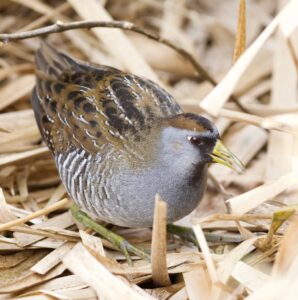PROVINCETOWN — It’s hard to predict when you might find a rare bird. You might try after a hurricane, a good night of migration, or some other event that seems sure to deliver something rare, but good conditions are no guarantee of good birds.
Fortunately, it’s also true that bad conditions don’t mean that no good birds are around.
Last Thursday’s editorial meeting at the Independent was held during a nor’easter. I had gone with a friend to White Crest Beach in Wellfleet early that morning, hoping the strong easterlies would blow in some unusual oceangoing birds. But, after 40 minutes watching the sea from the shelter of my car, we had nothing to show for our efforts except a handful of black scoters — sea ducks that are abundant on the Cape in the winter. The storm was a bust, it seemed.
The meeting at the newspaper’s Commercial Street office was chugging along. I had taken a seat facing a window that looks onto the alley behind Marine Specialties. The wind howled outside. Then I noticed a bird, perched on the roof of a shed just outside the window, cowering from the violent gusts.

The bird was completely backlit, so it was hard to make out any features. Based on little more than its size, I dismissed it as a mourning dove. But my eyes kept wandering to it and I noticed something strange: it didn’t seem to have a tail, and its beak was weirdly triangular. Then it turned its head, and I caught a hint of a black mask. Something clicked in my mind, and I realized this was something unusual.
I got up as casually as I could and headed over to the window. Closer now, I could see the lack of tail was no illusion. Its stout body was gray, its back was brown, and its bill was bright yellow. My suspicions were confirmed: it was a sora, a mostly nocturnal chicken-like bird that skulks through freshwater marshes. It’s a tough bird to find on the Outer Cape even in its preferred habitat. And yet here was one in town, in the middle of a storm, right behind a business on Commercial Street.
“I hate to interrupt, but there’s a really rare bird right there,” I said. I couldn’t contain the excitement in my voice. The meeting stopped, and the whole staff ran over to get a look at the sora before it flew off, I hope to a more suitable patch of habitat.
I’m not proud to say I derailed a meeting for a bird, and I know I seemed like a lunatic when I did it. But the sudden appearance of a rarity hijacked my brain.
It seems that every rare bird I’ve found on the Cape has come into view when I’m not birding. Forget the dozens of mornings spent actively birding along the Herring River, or in the Beech Forest, or scanning Provincetown Harbor. Clearly the best way to find a rarity is to go somewhere with no plans of seeing any birds at all.
Take the northern parula that I found last Thanksgiving, feeding in a hedge along Commercial Street, two blocks down from PAAM. I was in the middle of the Turkey Trot 5K when I found it. While parulas breed out here, they usually leave by the beginning of October. This was the second latest one ever seen on the Outer Cape, according to eBird, the bird data website.
I had a similar shock last summer, biking along the Cape Cod Rail Trail in Wellfleet. Tearing along, my girlfriend and I flushed a flock of sparrows. As they flew away chittering, I heard the distinctive twitter of a dark-eyed junco.
I slammed on the brakes. Juncos are abundant here in the winter, but summer sightings are unheard of. But the junco soon flew back onto the trail, giving me enough time to snap a picture of it in all its gray-bodied, pink-billed glory. According to eBird, that sighting was the only one from the Outer Cape that summer.
Each time, finding one of these birds has turned an otherwise unremarkable day into a story and left me with a high that I felt for hours afterwards. Talk to other birders, and they are sure to have similar experiences. These sightings serve as a reminder of a strange paradox: rare birds are everywhere. It pays to trust the little voice in your head that says “give that bird a second glance.”
There’s a flip side, of course. For every successful rare find, I can tell you about a dozen “ones that got away.” The massive all-dark falcon in a snowstorm in Ottawa, Ontario that was probably the rare arctic-dwelling gyrfalcon. The dull flycatcher in Key West that might have been the Caribbean species La Sagra’s flycatcher, a species I had forgotten existed until I saw it late that night. The countless unusual gulls that have surely flown by the beach when I wasn’t paying close attention.
Field guide author David Sibley argued that the odds of a given rarity being found in the U.S. is probably lower than 10 percent and may be as low as 2 percent. In other words, for every rarity that is found, there are anywhere from 9 to 49 other rarities that go completely unobserved.
Sibley said it best: “There’s a good chance that right now, somewhere near you, there is a rare bird just waiting to be discovered.” You just have to be on the lookout — and be willing to embarrass yourself a little if you spot one of these birds when you’re around friends.



